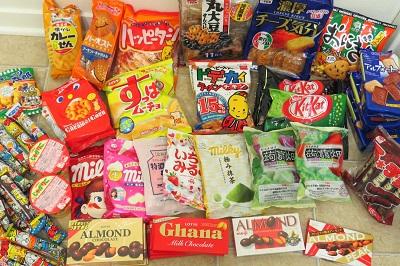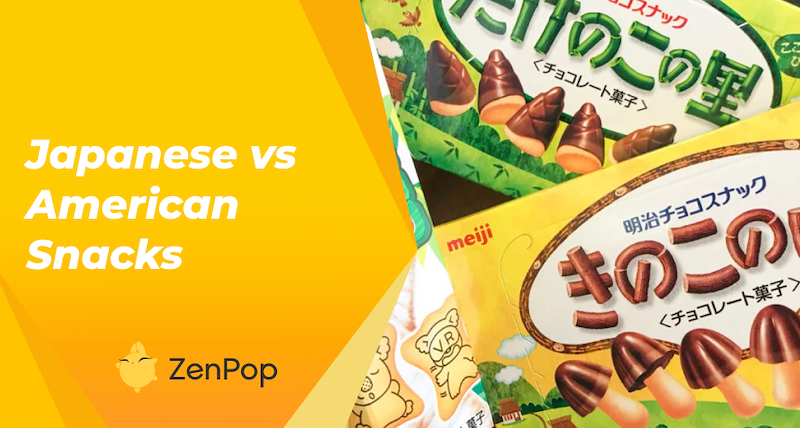
</title><meta name="robots" content="noindex"> Japanese Snacks vs American Snacks
Let’s face it, we all love junk food. When it comes to snacking, the world is a diverse and delicious place. From savory to sweet, crispy to chewy, and everything in between, snacks are a key part of our daily lives. In this culinary showdown, we'll explore the fascinating differences between Japanese snacks and American snacks, both of which offer unique flavors, textures, and cultural significance.
JAPANESE SNACKS VS. AMERICAN SNACKS - HISTORY
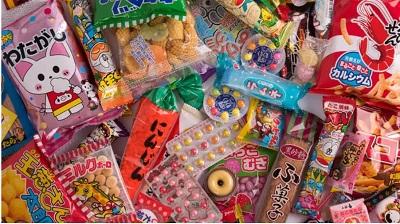
Japan is renowned for its culinary artistry, and its snacks are no exception. They often reflect the country's rich food culture and attention to detail. As far back as the Edo period, which was between 1603 and 1868, people would crush and roll nuts and then use thick malt syrup to sweeten them to create a snack. It was called “dagashi” which meant bad snack because of the low-quality ingredients, and it was only sold to poor masses.
However, in the Meiji era, from 1868 to 1912, Japanese snacks changed because imported sugar became available. That's when traditional snacks like taiyaki, senbei, konpeito, along with drinks like ramune and calpis were created. By the late 1900s (1960s), Japan would start mass producing popular snacks like Pocky, Caramel corn, and Pretz. Today, the revenue in the Confectionery and snacks market in Japan amounts to a whopping US$ 256.7 billion in 2023, and it is expected to keep growing.
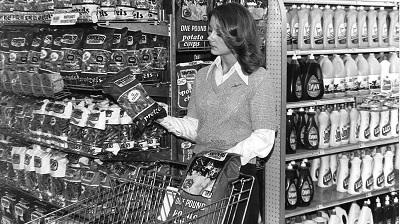
American snacks, on the other hand, started in the 1800s when peanuts were sold by street vendors. Similar to Japanese history, these snacks were seen as food for the poor by the richer masses. Vendors decided to upgrade the quality of snacks by packaging them to keep them fresher, and the richer class finally caught on to the awesomeness of snacks.
From the late 1800s to the early 1900s, snacks like hotdogs, waffles, and cotton candy were sold at fairs. Around 1912, Oreos were created, and others like Nestle Drumsticks, Reese’s peanut buttercups, and 7 Up were made in the 1920s. Since then, Americans have created iconic snacks like Lays, Mars, and M&Ms and generated the most snack revenue globally, with US$ 304 billion in 2023.
JAPANESE SNACKS VS. AMERICAN SNACKS - SIZE
Japanese snacks are made in smaller packages compared to American snacks. It’s a traditional thing because, right from the early times, snacks were made in bite-sized portions that people could wrap up and take home. Mochi, dango, and taiyaki are small, round, traditional Japanese snacks that are perfect examples of how Japanese people like their snacks. Americans are known for their love of supersized portions, and snacks are no exception. Jumbo-sized bags of chips, giant candy bars, and king-size candy boxes are examples of snacks you’ll generally find in American stores.
The difference in size is clear even in snacks produced by the same company. For instance, Japanese Kit Kats are smaller than American Kit Kats. It is a mini size weighing only 12g, while American Kit Kats weigh up to 42g. Let's compare another similar type of corn puffs snack, Cheetos (American) and Tohato Caramel Corn (Japanese). We find that the regular-sized Cheetos is 240g and Tohato Caramel Corn is just 68g.
JAPANESE SNACKS VS. AMERICAN SNACKS - FLAVOR
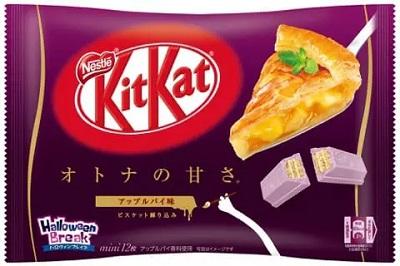
When it comes to flavor, Japanese snacks often embrace all types of flavors, including the fifth taste, umami. This savory, complex flavor is found in ingredients like seaweed, miso, and soy sauce, which are frequently used in Japanese snacks. In Japan, you’ll find snacks like nori (seaweed) flavored rice crackers, and wasabi peas. They don’t just stop at local flavors. Japanese snack manufacturers try to imitate Western flavors and create snacks like hamburger-flavored chips, pizza-flavored Kit Kat (yes, it exists in Japan), and apple pie-flavored Kit Kats.
One hallmark of American snacks is the delightful interplay of sweet and salty flavors. Pretzels coated in chocolate, kettle corn popcorn, and chocolate-covered potato chips are just a few examples of this simple flavor palette. American flavors are simple, and they work for some people, but compared to the variety of Japanese snacks offered, they may come off as boring in the flavor aspect.
JAPANESE SNACKS VS. AMERICAN SNACKS - PACKAGING
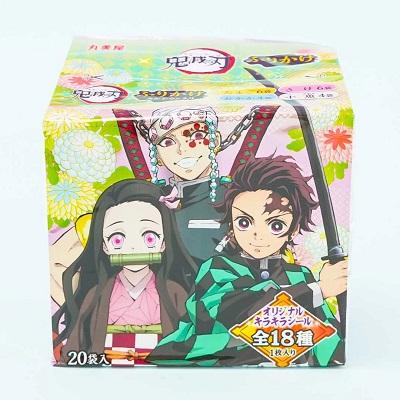
Japanese snacks are known for their beautifully designed packaging, which adds to the overall experience of enjoying Japanese snacks. Japan is home to some iconic characters from the Hello Kitty franchise, and anime shows, so it is a big marketing opportunity to incorporate them in merchandise and other products.
Sometimes, snacks will have limited edition versions in collaboration with companies to bring in more customers. That's why you can find One Piece, Naruto, or Bleach snacks in Japan. What's interesting is that it’s not just the packaging that is changed; these companies can sometimes change the taste of the product to represent the character. In America, snack packages are changed to celebrate holidays like Christmas, new years, sports events, and Independence Day, but there are not as many character collaborations.
JAPANESE SNACKS VS. AMERICAN SNACKS - DIVERSITY

Japanese snacks often follow the seasons, offering limited-time flavors and ingredients tied to specific times of the year. For example, sakura (cherry blossom) flavored snacks are popular in spring when the flowers bloom, while chestnut-flavored treats emerge in the fall. Companies use this to please their Japanese customers. For instance, Japan’s Starbucks sells sakura-flavored coffee during springtime, and you’ll find a lot of pink-colored or strawberry-flavored snacks to represent the season.
Additionally, snacks are regionally diverse in Japan, a company would produce flavors for only a district. Hokkaido is known for greenhouses that produce yubari melons. Kitkat collaborated with a chef to create the Yubari melon kit kat, which is mostly sold in Hokkaido. There are many other collaborations like this in Japan. The United States is a vast country with four seasons, but companies do not change snack flavors according to the season. Rather, there are diverse regional flavors and snacks. For instance, there are the New York-style style pretzels and bagels that are chewier than usual, as well as snacks like New England clam-flavored potato chips or cakes that are popular on the East Coast.
JAPANESE SNACKS VS. AMERICAN SNACKS - INGREDIENTS
Japanese snacks tend to have lower sugar content compared to many American snacks. Traditional Japanese snacks often rely on natural sweetness from ingredients like red bean paste and sweet rice, which are not as heavily processed with added sugars. Many Japanese snacks aim for a balance of flavors, including umami, saltiness, and sweetness, rather than overwhelming sweetness.
On the other hand, American snacks often have higher sugar content, especially in the sweet and confectionery categories. This is because American consumers tend to enjoy sweeter flavors. To please the customers, the snacks are specifically designed to deliver a sweet flavor, with sugar being a key ingredient in candies, cookies, cakes, and chocolate-based snacks.
Japanese and American snacks offer distinct and delightful experiences, each with its own unique flavors, textures, and cultural influences. Ultimately, the choice between Japanese and American snacks comes down to personal taste, and the best way to decide is by savoring both and celebrating the culinary diversity they bring to our snack-loving world. So, grab your favorite snack, whether it's a crispy senbei or a gooey chocolate chip cookie, and enjoy the global journey of snacking!
Satisfy your cravings and experience the joy of authentic Japanese snacks. Don't miss out on this delectable adventure by buying a snack pack from Japan– click here to start your ZenPop subscription today!
This article was originally written by our freelance writer Umm-Kulthum Abdulkareem and edited by us.

